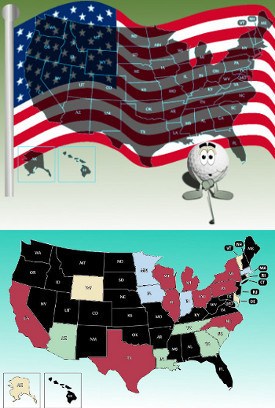
How much economic activity would you guess golf generates in a single year? A few billion dollars? $10 billion? $40 billion?
Try $68.8 billion. According to the National Golf Foundation (NGF), that was the total tally for 2011, a drop of 9.4% from the $75.7 billion generated in 2005, but still impressive given the economic shocks endured in the meantime.
You probably want to know exactly what comprises that gargantuan number. Here's a brief overview of the segments contributing to the overall golf economy:

- $29.852 billion – Golf course and facility operations (greens fees, membership dues, etc…)
- $5.639 billion – Golf equipment (clubs, balls, accessories, apparel)
- $3.9 billion – Charities
- $2.073 billion – Golf course capital investment (course and clubhouse renovation, new course construction, etc…)
- $2.045 billion – Media, tournaments and associations (player endorsements, ticket revenues, etc…)
- $20.555 billion – Hospitality and tourism (air travel, lodging, food and beverage, etc…)
- $4.745 billion – Real estate (golf course property “premiums,” etc…)

How does golf compare to other sports and entertainment industries when it comes to making cash registers ring? Pretty well. Check out the numbers for these select segments:
- TV broadcasting, cable and other subscription programming: $92.4 billion
- Movies and videos: $83.1 billion
- Spectator sports (football, baseball, basketball, etc…): $33.1 billion
- Other amusement and recreation (snow skiing, bowling, boating, fitness, etc…): $32.3 billion
If you have ever tried to call late in the week to make a tee time for a sunny Saturday morning, you would get the impression that golf is quite a popular game.

After all, it's tough to get onto the course on a nice weekend and rounds often have to be planned well in advance. All across the country, players vie for prime tee times and frequently spend hundreds of dollars to play on the top courses. Based on these signs, it would be easy to conclude that golf is going strong, as healthy and popular as it has ever been.
But is that the case? That is the topic at hand in this article. In recent years, there have been more and more stories popping up about the decline of golf. Some statistics seem to indicate that the popularity of the game has slid, especially among younger generations. You don't even need statistics to tell you that golf courses have been closing – you can just check newspapers around the country for stories of courses that are no longer able to remain in business. There are still millions of golfers, to be sure, but trying to get an overall picture of the health of this great game can be tricky.
We hope this article will bring some clarity to the current status of golf in the United States. Whether you are an avid golfer who likes to tee it up several times per week, or you only manage to get out once a month, you would probably like to know that golf is going to be around for the long run. Although there are some recent trends that have been moving in the wrong direction, the overall state of the game is relatively strong, and it doesn't seem like golf is going anywhere anytime soon.
Golf Health – Pros and Cons

Before we take a look at a few statistics, we wanted to have a general discussion about the state of the game. What elements of golf look strong as we move into the years ahead? What are the causes for concern? These points are not necessarily proven by any specific method, but rather they are general feelings from around the game. In most cases, you wouldn't have to look far to find someone who agreed with each of the points below. Where the disagreement might come in, however, is with regard to the importance of these points. Are the 'cons' too powerful for the 'pros' to overcome? Or do the good things about golf simply overwhelm the various drawbacks that people cite from time to time? These are questions with no definitive answer, as only time will be able to tell.
Let's take a quick look at some of the positive and negative points related to the modern-day game of golf.
- Pro – It's a great game. This has not changed over the years. Golf is an old game, but it remains a great game. It's fun for beginners and experienced players alike, although the game changes for each player as he or she gains experience. The challenge of the game is something that keeps people coming back, as is the beauty of many of the golf courses around the world. Golf is a game that allows you to be social and competitive at the same time, which is a combination not offered by many other hobbies. Also, in a world where people spend more and more time sitting down inside, golf gets you on your feet and out of the house. We could go on and on with this point. It's not by accident that golf has survived for centuries – it is a great game, and that has not changed.
- Con – It's expensive. This is another point that hasn't changed much over the years. Golf has long had a reputation as a game for the elite – those with the means to pay high greens fees and purchase expensive equipment. While this point might be overblown in some respects – it's possible to play golf without breaking the bank – there is no denying that this can be a pricey game. Compared to other recreational activities, you will have to spend quite a bit of money to play golf on a regular basis.
- Pro – Strong professional ranks. While the professional game doesn't actually have that much to do with amateur golf, there is some connection between the two. When the pro game is going strong, more sports fans are exposed to it – and more of those individuals will decide to go out and try this sport for themselves. Fortunately, pro golf is in a good place right now. There are plenty of star players to watch, both up-and-comers and legends of the game. The sport has an entire television channel dedicated to its coverage, so it would be hard to argue that no one cares about golf anymore.
- Con – Shrinking attention spans. When you read anything about the current state of the game of golf, you are sure to read about the shortening attention spans of the younger generation. And, to some extent, this does have to be considered. Kids are now growing up in a world where they have to wait for very little. With the internet always at their fingertips, it is easy to acquire the information they need or the entertainment they want. Will this generation be willing to spend four hours or more on a golf course to complete a round? Some will, of course, but will there be enough interest in this relatively slow game to sustain it into the future? That is the big question. Part of the beauty of golf is the fact that it takes several hours for a round to unfold, always with twists and turns along the way. In the end, it may come down to striking a balance between making the game as efficient as possible without causing players to feel rushed.
- Pro – Changes on the way. Recently, an updated version of the Rules of Golf was approved, with several changes designed to keep the game modern and relevant. This should be seen as a good sign for the future of the game. It is true that golf takes great pride in its history and tradition, but that can only go so far. If the game were to refuse to keep up with the times, it would become a dinosaur. Fortunately, some of the new rules are a big step in the right direction. Some people would argue that they have not gone far enough to modernize the game, but there is no doubt that these rule changes are a good start. If the powers that be in the game of golf are willing to adapt to the market, the game will have a much better chance at long-term survival.
Golf is not in a bad place. Is golf as popular as it has ever been? No – probably not. The game will go through natural ebbs and flows in popularity, and it is probably in a down period at the moment. That doesn't mean it is going away, however, and it certainly doesn't mean that millions of dedicated and passionate golfers are going to suddenly stop playing. There is simply too much to like about golf to paint such a bleak outlook.
Some Numbers

In this section, we are going to highlight a few interesting statistics with regard to the game of golf. Are statistics the only way to measure the current state of golf? No – as with all statistics, you have to make sure you are looking at the right numbers, and viewing them in the right context. Numbers can lie, if you don't use them correctly. With that said, it is still helpful to take a look at a few stats which will speak to the overall state of the game.
- Millions of active players. According to statista.com, as of spring 2017, 25.95 million people had played at least one round of golf in the last 12 months (in the United States). That is a big number. Surely, if golf was a dying sport – as some people will have you to believe – fewer than 25 million people would be actively participating. With that said, it should be stated that the number is smaller than it was several years prior. For instance, in spring 2009, that number was measured at 29.42 million people. There is a meaningful decline there, but participation in the game has not fallen off a cliff. People still play golf, even if fewer of them are active as compared to a few years back. It should be noted that the economy of the US as a whole likely played a role in these statistics. The economic crisis was just starting to settle in during the period of 2008 – 2009, when golf participation was stronger. It has declined in the following years, meaning some of that loss may be attributable to the economy rather than the game itself.
- Courses are closing. According to an article on golfadvisor.com, which quotes National Golf Foundation statistics, 211.5 golf courses closed across the country in 2016. While the 2017 losses aren't tallied up just yet, there are sure to be plenty more to add to that number. So, does this mean the golf business is falling apart? Not at all. Sure, it is a difficult time to turn a profit for many golf courses, but there are plenty of others who are thriving. A large number of new courses had been built in the last 20 years or so, making it an easy argument to say that the game had outgrown its natural size. With these closures, the golf market may simply be stabilizing. It is unfortunate that some excellent courses are going to be lost as part of that market normalization, but that's business. Golfers can hope that the closures will come to a stop once the number of courses available matches up nicely with the number of active players in a given geographical area.
- Not as expensive as you might think. We've already mentioned the reputation golf has for being an expensive game, and that reputation is certainly earned to a degree. But the notion that golf is out of reach for many people may have been taken too far. According to information posted in a Golfweek article, the median cost of 18-holes with a cart on a weekend is between $36 and $40, depending on the type of course. Sure, there are courses out there which charge $100 or more for a round, but those are the exception rather than the norm. Considering you get several hours of recreation in exchange for your money, paying around $40 seems like a pretty good deal. Obviously, that number does not include some of the other costs that come along with golf, such as buying equipment, clothes, shoes, etc.
The statistics do not paint an ugly picture of the game as a whole. Yes, it is clear that overall participation in down in recent years, but the underlying reason for that drop is not obvious. Are golfers just leaving the game because they don't want to play, or is the economy at least partially to blame? You can make up your own mind on that question. Either way, there are still millions of golfers across the country, and those players are actively taking to the links in their local area.





